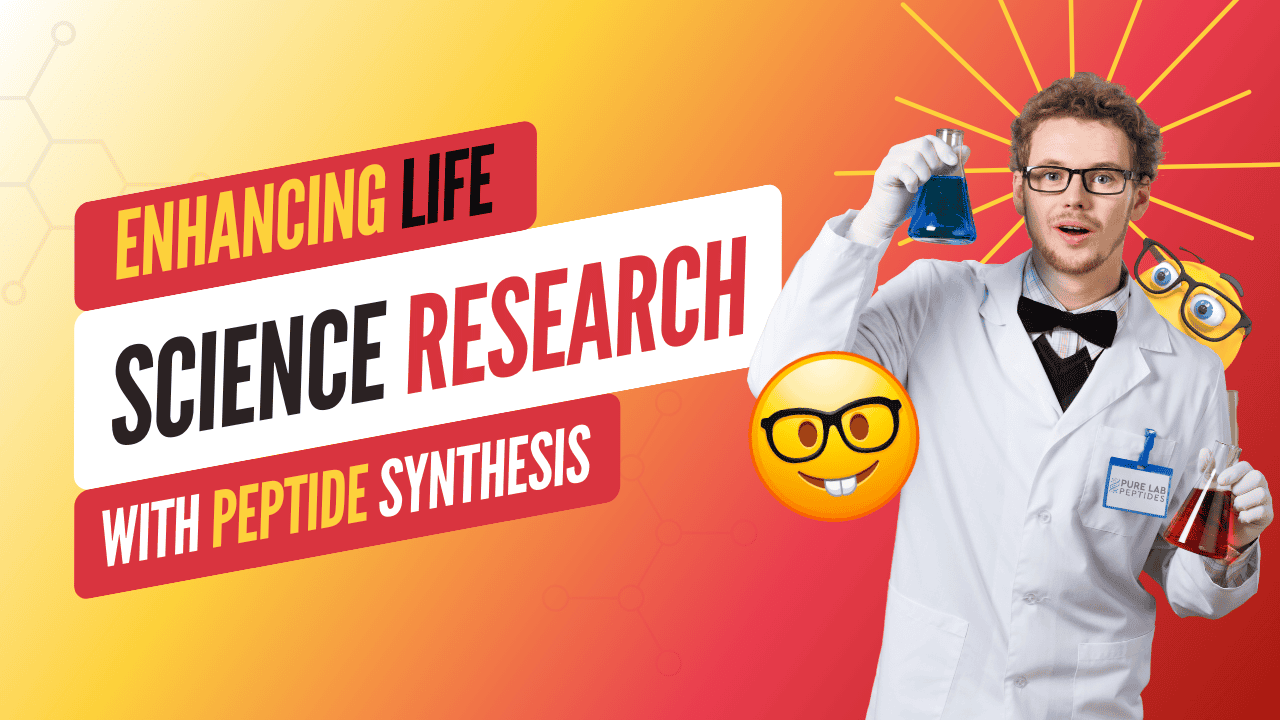

Peptides are at the frontier of scientific breakthroughs in medicine, nutrition, and cosmetics.
Dive into this comprehensive guide to understand their structure, types, and versatile applications.
This article promises an insightful exploration for both novices and enthusiasts, making complex concepts digestible and fascinating.
Let’s kick things off with the basics. A peptide is a short chain of amino acids linked by peptide bonds. Think of peptides as smaller siblings to proteins—they pack quite a punch despite their modest size. Now, you might be wondering, “Why should I care about peptides?” Well, peptides are everywhere in the body, from aiding muscle growth to regulating hormones.
In scientific terms, a peptide is a short chain of amino acids joined by bonds called peptide bonds. They are shorter than proteins, usually containing up to 50 amino acids. This concise nature allows them to take on roles that larger, bulkier proteins can’t manage.
Ah, the age-old question. While both peptides and proteins are made from chains of amino acids, the difference lies in their length. Proteins are long molecules made of over 50 amino acids. Peptides, however, fit snugly into a shorter range, which makes them nimble and versatile in their functions.
Peptides are akin to the building blocks of life. One amino acid joins another through a special bond called a peptide bond. This molecular connection shapes the structure and function of the peptide. It’s like how tiny Lego pieces snap together to form complex structures.
Peptides are extraordinarily intricate despite their small size. Let’s dig into what makes these molecules tick.
A peptide bond is the hero of our peptide story. It forms when one amino acid’s carboxyl group links with another amino acid’s amino group. This bond is both strong and flexible, allowing peptides to take on various shapes.
Alright, brace yourself: chemistry ahead! When the carboxyl group of one amino acid reacts with the amino group of another, an amide bond is formed, releasing a water molecule. This reaction is fundamental to creating peptides.
Though peptides tend to be small, the bonds that hold them together are sturdy. There are primary peptide bonds, and sometimes, secondary and tertiary interactions come into play due to the peptide’s three-dimensional structure.
When many peptides link up, they form a protein. This process is akin to assembling a complex jigsaw puzzle, where each piece fits precisely to form the final image.
The specific sequence of amino acids dictates a peptide’s unique structure. Each sequence leads to different folding and unique functions, almost like a molecular fingerprint.
Molecular biology offers tools and techniques to comprehend peptides better. By studying how these molecules interact and behave, we can unlock their vast potential in medicine, biotechnology, and beyond.
Understanding the various types of peptides opens up a world of possibilities. From therapeutic uses to everyday skincare, peptides are everywhere.
Peptides come in different shapes and sizes, but they can generally be classified based on their structure and function. Common classifications include linear peptides, cyclic peptides, and bioactive peptides.
Bioactive peptides are specific fragments that have a beneficial effect on body functions or conditions. Think of them as the “special forces” of the peptide world, actively improving health and wellness.
A peptide chain is a sequence of amino acids linked together. This chain can vary in length but typically ranges from short peptides to longer chains approaching the size of small proteins.
Linear peptides are straightforward, with amino acids linked end-to-end. Cyclic peptides involve cross-links that form rings, adding stability and specific function.
Synthetic peptides are lab-created, designed to mimic natural peptides or introduce new functionalities. They are invaluable in research, medicine, and even cosmetics.
Natural peptides are sourced from food, plants, and even microorganisms. They often play roles in signaling within the body, as antimicrobial agents, and more.
Here’s a quick glance:
| Type | Features | Functions |
|---|---|---|
| Linear | Straight chains | Versatile functions |
| Cyclic | Ring-forming | Stability, specificity |
| Bioactive | Functional fragments | Health benefits, signaling |
| Synthetic | Lab-created | Research, therapeutic applications |
Let’s delve deeper into how these two biological giants compare and contrast.
Proteins are essentially large peptides. When peptides link in long chains (over 50 amino acids), they form proteins, which then fold into specific shapes to perform a variety of functions.
While peptides are short chains of amino acids, proteins are more extensive, complex molecules. Peptides perform quick, specific tasks, whereas proteins often have more prolonged, structural, or regulatory roles.
In protein synthesis, peptides are the building blocks. Ribosomes read RNA sequences to assemble amino acids into peptides, which then fold into functional proteins—an orchestration worthy of a symphony.
Their shorter length allows peptides to be more flexible and participate in diverse biochemical processes, making them ideal for specialized functions like hormone signaling and enzyme activity.
The realm of molecular biology provides profound insights into peptides’ inner workings, elucidating their roles and interactions.
Molecular biology techniques help us unravel the structure, function, and potential of peptides. It enables us to design and manipulate peptides for research, medicine, and industry.
Techniques like mass spectrometry, X-ray crystallography, and NMR spectroscopy are pivotal in studying peptide structure and function, providing a detailed look into their molecular landscapes.
Peptides engage in numerous interactions within the body. From binding to receptors to forming complexes with other biomolecules, these interactions are vital for many physiological processes.
Peptides are not just theoretical delights; they have practical, real-world applications.
Therapeutic peptides hold promise in treating diseases due to their specificity and effectiveness. They are used in therapies for cancer, diabetes, and even autoimmune diseases.
Peptides in medicine range from hormone replacements to cancer treatment. They offer precise targeting with fewer side effects compared to traditional drugs.
Peptide drug discovery is an exciting frontier. Researchers are constantly discovering new therapeutic peptides that can offer solutions to some of the most challenging medical conditions.
Bioactive peptides have roles in nutraceuticals and functional foods, enhancing health and preventing disease. Their potential in medicine is vast, with ongoing research exploring new applications.
In cosmetics, peptides are hailed for their anti-aging properties. They boost collagen production, reduce wrinkles, and improve skin elasticity—miracles in a tiny package.
Peptides in agriculture? You bet! Peptides can act as growth enhancers, pest control agents, and stress resistance factors, offering eco-friendly solutions.
Peptides are excellent biomarkers for diagnosing diseases. They can reveal the presence and progression of conditions through simple tests.
Developing peptide drugs is an intricate but rewarding process.
Peptides are biologically active and highly specific, making them excellent candidates for targeted therapies. Their high efficacy and low toxicity make them safe and effective drugs.
Despite their potential, developing peptide drugs poses challenges like stability, delivery methods, and production costs. Overcoming these hurdles is the focus of ongoing research.
New peptide-based therapeutics are emerging, offering optimism for diseases that were previously hard to treat. Innovations in peptide synthesis are paving the way for a new class of medication.
Peptide drugs can be administered in various ways, including injections, oral formulations, and topical applications, each having its benefits and challenges.
Generally, peptides are safe when used appropriately. However, like any other substance, they can have side effects and should be used under guidance.
Peptides can complement conventional drugs and, in some cases, offer better-targeted therapies. However, they may not entirely replace all traditional medications.
Peptides work by interacting with specific receptors or enzymes, triggering biological responses. Each peptide has a unique action mechanism based on its structure.
While peptides are generally safe, they can cause side effects like any other therapeutic. Side effects vary depending on the peptide and its application.
Peptides vary in types and functions, making classification insightful.
Peptides are categorized based on structure, origin, and function. The main categories include linear, cyclic, and bioactive peptides, each playing distinct roles.
Peptides are classified based on their sequence length, function, and source. These criteria help in understanding their roles and potential applications.
Functional classifications include signaling peptides, antimicrobial peptides, and others. Each class has unique attributes and purposes in biological systems.
The journey of peptides is just beginning.
Trends include developing novel therapeutic peptides, improving stability and delivery methods, and expanding applications in diverse fields like agriculture and cosmetics.
Future applications are endless, from advanced medical therapies to next-gen skincare products. Peptides hold promise in virtually every industry.
Cutting-edge technologies like CRISPR and AI are revolutionizing peptide research, making it faster and more accurate to discover and develop new peptides.
While challenges exist, like formulation stability and cost, the opportunities are vast. With continued research and innovation, peptides will likely play pivotal roles in future scientific and medical advancements.
Bioactive peptides are small but mighty.
Bioactive peptides are specific peptide fragments that can influence bodily functions, making them crucial in health and wellness. They are the special agents in the peptide world.
Bioactive peptides contribute to various health benefits, from anti-inflammatory effects to improving cardiovascular health. They unlock new pathways for preventive health measures.
Bioactive peptides are often derived from food sources, like milk, meat, and eggs, and can also be created synthetically.
In functional foods, bioactive peptides offer health benefits beyond basic nutrition. They are incorporated into products to enhance health and prevent diseases.
Examples help crystallize the concepts.
Insulin, a peptide hormone, is vital in regulating blood sugar levels. It’s a prime example of a peptide’s critical role.
Oxytocin, often termed the ‘love’ peptide, influences social behaviors, bonding, and emotional responses. It’s fascinating how a tiny molecule can impact relationships!
Collagen peptides are used in skincare for their anti-aging properties. They help maintain skin elasticity and reduce wrinkles.
Antimicrobial peptides are key players in the immune system, destroying harmful bacteria and pathogens. They offer a promising avenue for new antibiotics.
Creating peptides is an art and a science.
Peptide synthesis involves scientifically assembling amino acids into sequences. It’s either done chemically in the lab or biologically in living organisms.
Techniques include solid-phase peptide synthesis and solution-phase synthesis. Each method has its pros and cons, depending on the peptide’s intended use.
Challenges include ensuring purity, stability, and functional efficacy. Overcoming these requires advanced techniques and technologies.
Synthetic peptides are used in research, therapy, and industry, offering customized solutions where natural peptides fall short.
Peptides are revolutionizing biotechnology.
Peptides play critical roles in biotechnology, from drug development to agricultural advancements. Their versatility makes them invaluable tools.
Bioengineering utilizes peptides for various applications, such as developing biocompatible materials and enhancing disease resistance in crops.
Innovations include using peptide synthetases for nonribosomal peptide synthesis, a method offering vast potential for creating unique peptides.
Peptides, despite their small size, are powerhouses of potential. With applications spanning medicine, cosmetics, and biotechnology, understanding peptides can open doors to significant innovations.
Understanding and leveraging peptides will undoubtedly lead to leaps and bounds in scientific and medical advancements. Keep an eye on these mighty molecules—they’re just getting started!
The primary structure of a peptide refers to the linear sequence of amino acids in the chain. This sequence dictates the biological function of the peptide. The specific order of amino acids, linked by peptide bonds, determines how the peptide folds and interacts with other molecules.
A peptide chain consists of amino acids connected by peptide bonds. These chains can be short or long, forming polypeptides when the number of amino acids exceeds around 10. The specific sequence of amino acids along the chain defines the peptide’s properties and functions.
A peptide bond is a type of covalent bond that links two amino acids together in a peptide. It forms between the carboxyl group of one amino acid and the amino group of another, releasing a molecule of water (H2O) in the process. This bond is fundamental in creating the peptide chain.
A peptide is a short chain of amino acids linked by peptide bonds. Peptides can range from dipeptides, made of two amino acids, to oligopeptides and polypeptides, with many amino acids. Peptides are smaller than proteins and are involved in various biological functions like signaling and enzymatic activity.
A peptide bond has a planar structure and exhibits partial double-bond character, restricting rotation and providing stability. It occurs between the carboxyl group of one amino acid and the amino group of another, creating a continuous backbone with alternating carbon and nitrogen atoms.
A peptide bond is a chemical bond that forms between two amino acids during a dehydration reaction. This bond links the carboxyl group of one amino acid to the amino group of another, forming a stable and linear chain of amino acids called a peptide.
Peptides feature a backbone of amino acids connected by peptide bonds. The side chains (R-groups) of the amino acids protrude from this backbone, influencing the peptide’s chemical properties and interactions. Peptides can form secondary structures like alpha-helices and beta-sheets.
Peptide bonds do not occur in DNA; they are specific to proteins and peptides. DNA uses phosphodiester bonds to link nucleotides, forming its backbone. However, peptide bonds are crucial in translating genetic information from DNA into functional proteins via peptide synthesis.
A peptide group consists of the atoms involved in a peptide bond: the carbonyl carbon, its double-bonded oxygen, the nitrogen connected to the next amino acid, and the hydrogen attached to this nitrogen. This configuration supports stable and specific folding of peptide molecules.
Dr. Samir Hanash is a prominent figure in the field of peptide research, notably recognized for his innovative work in biomarker discovery. With over 30 years of experience, Dr. Hanash’s research has profoundly impacted the identification and application of peptides in cancer diagnostics and treatment. His expertise centers around peptide-based biomarkers, which are critical in early disease detection.
Dr. Hanash’s notable publications include:
Dr. Hanash’s work is celebrated for its innovative approach and unwavering commitment to advancing medical diagnostics. His research has garnered multiple awards, including recognition from the American Association for Cancer Research, cementing his authority and trustworthiness in peptide biomarker research.
Dr. Kim Lewis is a distinguished researcher in the field of antimicrobial peptides, particularly known for his pioneering studies in bacterial persistence and resistance. With a career spanning over two decades, Dr. Lewis has significantly contributed to understanding how antimicrobial peptides combat bacterial infections, paving the way for novel antibiotic therapies.
Key publications by Dr. Lewis include:
Dr. Lewis’s work is marked by its depth and innovation, making significant strides in the battle against antibiotic-resistant bacteria. His contributions have been recognized with numerous accolades, including the NIH Director’s Pioneer Award, highlighting his expertise and the impactful nature of his research in the peptide field.
ALL ARTICLES AND PRODUCT INFORMATION PROVIDED ON THIS WEBSITE ARE FOR INFORMATIONAL AND EDUCATIONAL PURPOSES ONLY. The products offered on this website are intended solely for research and laboratory use. These products are not intended for human or animal consumption. They are not medicines or drugs and have not been evaluated or approved by the FDA to diagnose, treat, cure, or prevent any disease or medical condition. Any form of bodily introduction is strictly prohibited by law.




Discount Applied Successfully!
Your savings have been added to the cart.